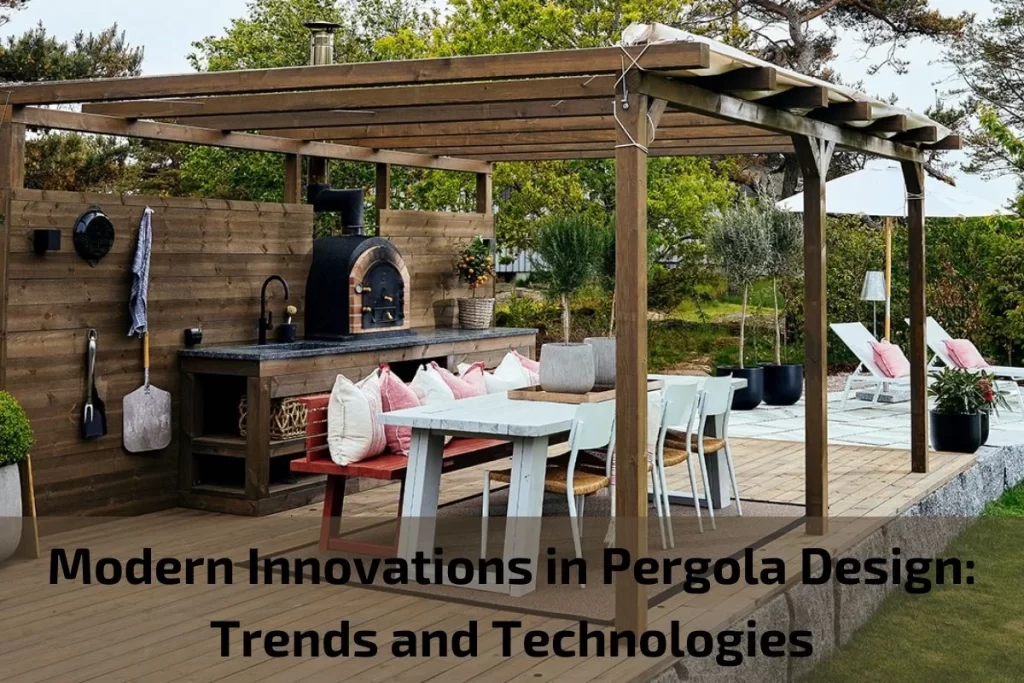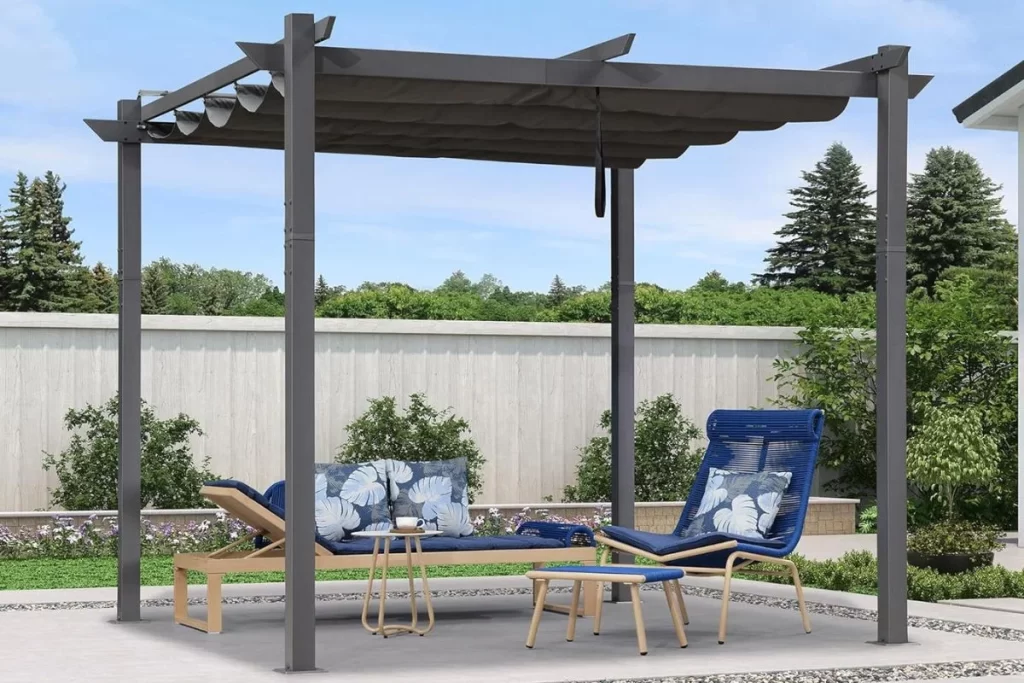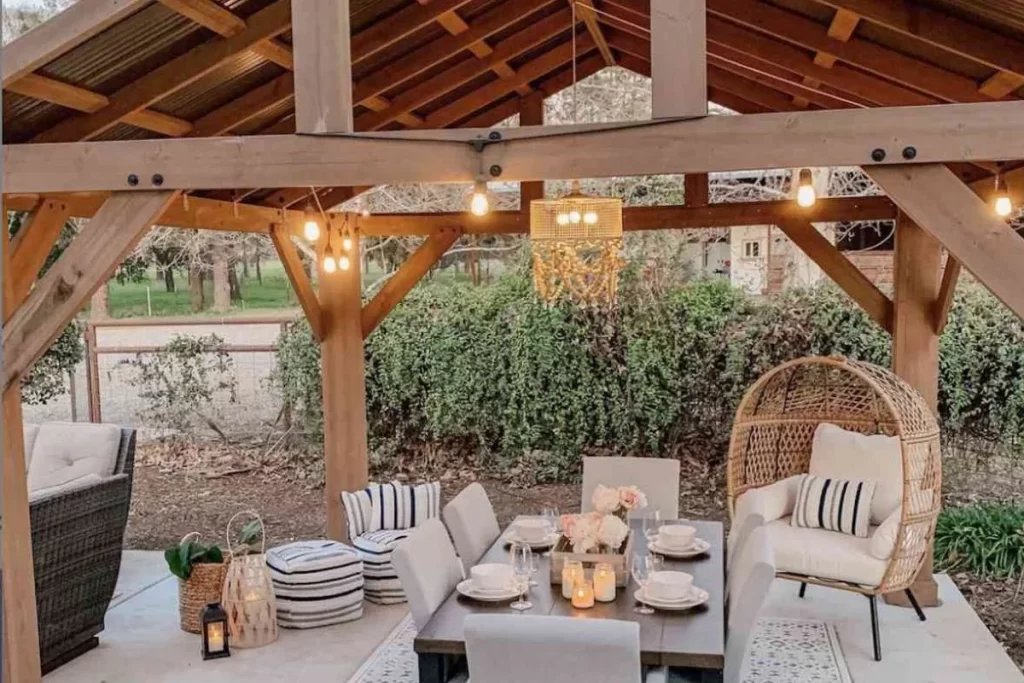
In the realm of outdoor architecture and design, pergolas stand as iconic structures that seamlessly blend form and function, offering a harmonious extension of indoor living to the great outdoors. As the demands of modern living evolve and technology advances, so too does the world of pergola design. Today, we find ourselves at the forefront of a revolution in outdoor living spaces, where innovation and ingenuity converge to redefine the traditional concept of pergolas.
In this exploration of “Modern Innovations in Pergola Design: Trends and Technologies,” we embark on a journey to discover the cutting-edge developments shaping the landscape of outdoor architecture. From state-of-the-art materials to smart features and sustainable practices, we delve into the latest trends and technologies that are revolutionizing the way we conceive, construct, and enjoy pergolas.
Join us as we unravel the fascinating world of modern pergola design, where creativity knows no bounds and the boundaries between indoor and outdoor living blur. From urban rooftops to suburban backyards, these innovative structures are redefining outdoor spaces and inspiring a new generation of outdoor enthusiasts. Let’s explore the trends and technologies that are shaping the future of pergola design, and discover how they can elevate your outdoor living experience to new heights.
Definition and Purpose of Pergolas
Pergolas are architectural structures characterized by their open framework of vertical posts or pillars that support cross-beams and an open lattice or slatted roof. Originating from ancient civilizations, pergolas have evolved from functional structures to ornamental features in modern outdoor design.
The primary purpose of pergolas is to provide a defined outdoor space that blurs the boundaries between the indoors and outdoors. They serve as transitional elements that connect different areas of the landscape while creating shaded retreats from the sun. Pergolas often function as focal points in gardens, patios, and backyard landscapes, offering a sense of intimacy and architectural interest to outdoor environments.
Beyond their aesthetic appeal, pergolas serve practical purposes as well. They provide shade and protection from the sun’s harsh rays, making them ideal for outdoor dining areas, lounging spaces, or as extensions of the home’s living areas. Additionally, pergolas can support climbing plants such as vines, roses, or wisteria, adding natural beauty and shade while enhancing the ambiance of the space.
In essence, pergolas blend form and function, offering a versatile outdoor structure that enhances the beauty and functionality of any outdoor space. Whether used for entertaining guests, relaxing with family, or simply enjoying the beauty of nature, pergolas serve as timeless additions to residential and commercial landscapes alike.
Importance of Pergolas in Outdoor Design
Pergolas play a pivotal role in outdoor design, offering a multitude of benefits that enhance the functionality, aesthetics, and ambiance of outdoor spaces. Here’s a closer look at the importance of pergolas in outdoor design:
Defining Outdoor Spaces: Pergolas provide a sense of structure and definition to outdoor areas, delineating spaces for dining, lounging, or entertaining. They create natural transitions between different zones of the landscape, such as connecting the patio to the garden or framing the entrance to a backyard retreat.
Adding Architectural Interest: With their distinctive design elements, including vertical posts, cross-beams, and lattice roofs, pergolas contribute architectural interest to outdoor environments. They serve as focal points that draw the eye and add visual appeal to gardens, patios, and backyard landscapes.
Creating Shaded Retreats: One of the primary functions of pergolas is to offer shade and shelter from the sun’s rays. By providing a partial covering overhead, pergolas create comfortable outdoor spaces where individuals can seek refuge from the heat while still enjoying the beauty of the outdoors.
Enhancing Outdoor Living: Pergolas extend the living space of the home into the outdoors, allowing homeowners to maximize their enjoyment of the surrounding landscape. Whether used for alfresco dining, relaxing with a book, or hosting gatherings with friends and family, pergolas create inviting environments for outdoor living and entertainment.
Encouraging Outdoor Activities: The presence of a pergola encourages individuals to spend more time outdoors, engaging in leisure activities and connecting with nature. Pergolas provide a versatile backdrop for various outdoor pursuits, from casual gatherings and intimate conversations to yoga sessions and garden parties.
Supporting Climbing Plants: Pergolas serve as ideal structures for supporting climbing plants and vines, adding a lush and verdant element to outdoor spaces. The intertwining foliage not only enhances the visual appeal of the pergola but also provides additional shade and privacy for those underneath.
Increasing Property Value: Well-designed pergolas can enhance the overall value and appeal of a property. They contribute to the curb appeal of the home, making it more attractive to potential buyers and adding to the overall desirability of the outdoor living space.

Benefits of Pergolas
Pergolas offer a multitude of benefits that make them valuable additions to outdoor spaces. Here are some of the key advantages of incorporating pergolas into your landscape design:
Shade and Sun Protection: Pergolas provide partial shade and protection from the sun’s intense rays, allowing individuals to enjoy outdoor spaces comfortably even during the hottest parts of the day. The overhead lattice or slatted roof of a pergola helps to filter sunlight, creating a cool and shaded retreat.
Enhanced Outdoor Living: By extending the usable living space of the home into the outdoors, pergolas create inviting environments for relaxation, dining, and socializing. They serve as versatile settings for outdoor activities and gatherings, encouraging individuals to spend more time enjoying the beauty of their outdoor surroundings.
Architectural Interest: Pergolas add architectural interest and visual appeal to outdoor landscapes with their distinctive design elements. Whether constructed from wood, metal, or vinyl, pergolas provide a focal point that enhances the aesthetic charm of gardens, patios, and backyard retreats.
Versatility in Design: Pergolas come in a variety of designs, sizes, and styles to suit different preferences and architectural themes. From traditional wooden structures with intricate detailing to modern minimalist designs with clean lines, pergolas offer endless possibilities for customization and personalization.
Support for Climbing Plants: Pergolas provide ideal support structures for climbing plants and vines, allowing greenery to flourish and intertwine with the framework. The addition of climbing plants not only enhances the beauty of the pergola but also creates a natural canopy of foliage that provides additional shade and privacy.
Defined Outdoor Spaces: Pergolas help to define outdoor spaces and create visual boundaries within the landscape. They serve as transitional elements that seamlessly connect different areas of the garden or patio, providing a sense of structure and organization to the outdoor environment.
Increased Property Value: A well-designed and well-maintained pergola can enhance the overall value and appeal of a property. Pergolas contribute to the curb appeal of the home, making it more attractive to potential buyers and adding to the overall desirability of the outdoor living space.
Choosing the Right Pergola for Your Space
Selecting the perfect pergola for your outdoor space requires careful consideration of several key factors. Here’s a guide to help you make the right choice:
Size and Scale: Begin by assessing the size and scale of your outdoor area to determine the appropriate dimensions for your pergola. Consider factors such as available space, the layout of your landscape, and any existing structures or features that may impact the placement and size of the pergola.
Material Selection: Pergolas are available in a variety of materials, including wood, metal, vinyl, and composite materials. Each material offers unique benefits in terms of durability, aesthetics, and maintenance requirements. Choose a material that complements the style of your home and suits your personal preferences.
Design Style: Consider the design style that best fits your outdoor space and architectural theme. Traditional pergolas feature classic elements such as wooden posts, lattice roofs, and decorative details, while modern pergolas may have sleeker lines and minimalist designs. Select a design style that enhances the overall aesthetic of your outdoor environment.
Integration with Landscape and Architecture: Take into account how the pergola will integrate with the existing landscape and architecture of your property. Consider factors such as sight lines, views, and focal points to ensure that the pergola complements the surrounding environment and enhances the overall visual appeal of your outdoor space.
Customization Options: Explore customization options to tailor the pergola to your specific needs and preferences. Choose from a range of features and enhancements, such as retractable canopies, built-in lighting, privacy screens, and decorative elements, to create a pergola that reflects your unique style and enhances the functionality of your outdoor living space.
Budget Considerations: Determine your budget for the pergola project and explore options that align with your financial parameters. Consider the upfront cost of materials and installation, as well as long-term maintenance and upkeep expenses, when making your decision.
Professional Installation vs. DIY: Decide whether to hire a professional contractor for the installation of your pergola or tackle the project as a DIY endeavor. While DIY installation may offer cost savings, professional installation ensures proper construction, adherence to building codes, and high-quality craftsmanship.
Creative Uses of Pergolas
Pergolas are versatile outdoor structures that lend themselves to a variety of creative uses beyond their traditional roles. Here are some imaginative ways to incorporate pergolas into your outdoor space:
Outdoor Dining Area: Transform your pergola into an enchanting outdoor dining area where you can enjoy meals with family and friends amidst the beauty of nature. Add a dining table and chairs beneath the pergola, along with soft lighting and ambient decor to create an inviting atmosphere.
Garden Retreat: Create a serene garden retreat by placing a pergola amidst lush greenery and colorful blooms. Use the pergola as a focal point for relaxing and unwinding, with comfortable seating, cozy cushions, and potted plants adding to the tranquil ambiance.
Reading Nook: Turn your pergola into a cozy reading nook where you can escape with a good book and immerse yourself in the joys of literature. Install a comfortable bench or hammock beneath the pergola, along with shelves for books and magazines, creating a peaceful sanctuary for quiet moments of reflection.
Outdoor Yoga Studio: Use your pergola as an outdoor yoga studio where you can practice yoga, meditation, and mindfulness in a serene natural setting. Roll out a yoga mat or lay down soft rugs beneath the pergola, surrounded by greenery and fresh air to rejuvenate mind, body, and soul.
Artistic Showcase: Showcase your artistic talents by using the pergola as a backdrop for creative projects and installations. Hang artwork, sculptures, or mobiles from the pergola beams, or use the space to display pottery, ceramics, and other handcrafted treasures, adding a touch of beauty and inspiration to your outdoor environment.
Alfresco Kitchen: Create an alfresco kitchen beneath the pergola, complete with a grill, countertop, and seating area for outdoor cooking and entertaining. Install shelves or cabinets for storage, along with hooks for utensils and accessories, making it easy to prepare and enjoy delicious meals in the great outdoors.
Outdoor Classroom: Use the pergola as an outdoor classroom or learning space where children can explore, discover, and engage with nature. Set up a table or benches beneath the pergola for educational activities, storytelling sessions, and hands-on experiments, fostering a love for the outdoors and the environment.

Maintaining Your Pergola
Maintaining your pergola ensures its longevity, functionality, and aesthetic appeal. Here are some essential maintenance tips to keep your pergola in top condition:
Regular Cleaning: Periodically clean your pergola to remove dirt, dust, and debris that can accumulate over time. Use a gentle detergent or mild soap and water solution to scrub the surfaces of the pergola, including the posts, beams, and lattice roof. Rinse thoroughly with water to remove any residue.
Inspect for Damage: Conduct regular inspections of your pergola to check for signs of damage or wear. Look for cracks, splits, or rot in the wood, rust on metal components, and loose or missing hardware. Address any issues promptly to prevent further deterioration and ensure the structural integrity of the pergola.
Repair and Replace: Repair any damaged or deteriorated parts of the pergola as soon as possible. Replace rotted or damaged wood components, tighten loose bolts and screws, and treat rusted metal surfaces with a rust inhibitor. Consider hiring a professional contractor for more extensive repairs or renovations.
Seal and Stain: Apply a protective sealant or stain to wooden pergolas to enhance their durability and resistance to the elements. Choose a high-quality sealant or stain that provides UV protection and waterproofing properties. Follow the manufacturer’s instructions for application and reapplication as needed.
Trim Vegetation: Trim and prune any overhanging vegetation or climbing plants that may be encroaching on your pergola. Trim branches, vines, and foliage to prevent them from causing damage or blocking sunlight. Consider planting vegetation strategically to complement the pergola without overwhelming its structure.
Inspect for Pests: Check your pergola regularly for signs of pests such as termites, carpenter ants, or wood-boring beetles. Look for holes, sawdust, or insect activity in the wood components of the pergola. If pests are detected, take appropriate measures to eliminate them and prevent further infestation.
Weatherproofing: Protect your pergola from the effects of weather exposure by applying a weatherproofing treatment. Consider using a water-repellent coating or waterproofing sealant to shield the wood from moisture and prevent rotting. Reapply weatherproofing treatments as needed, especially after heavy rainfall or prolonged exposure to the sun.
Seasonal Maintenance: Perform seasonal maintenance tasks to keep your pergola in optimal condition throughout the year. Inspect the pergola before the start of each season, clean away debris, and make any necessary repairs or adjustments to ensure it remains sturdy and functional in all weather conditions.
Conclusion
In conclusion, pergolas are versatile outdoor structures that enhance the beauty, functionality, and enjoyment of outdoor spaces. From providing shade and shelter to adding architectural interest and defining outdoor areas, pergolas serve as valuable additions to residential and commercial landscapes alike.



